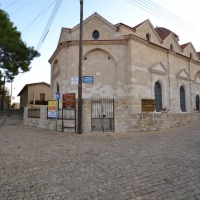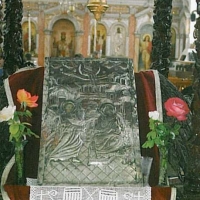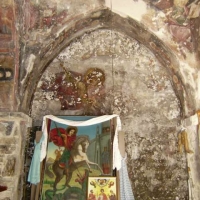Churches
Virgin Mary of Evangelism
The beautiful and picturesque vine village of Vasas Kilaniou is met when someone follows the route of Limassol going to the North West and in a distance of 35 kilometers. As we go to the inside of the village, we will see a unique church of its kind, dedicated to Virgin Mary of Evangelism.It would worth it for someone to visit this church. In the past though at the same place the church of Evangelism was built, right below, under the ground, there was the temple of Saint Varnavas, where some of the heritage remainders of this church are saved until today in the ecclesiastical museum of the community.
It started to be built in 1896-1900, with the resident’s expenses and in 1903 the opening of the church took place. In 1906 the temple was made.The church has a special ornamental work of art, in the outside and the inside too.It is a big church and has the capacity to take in 500 people. Architecturally it is built in a gothic type with dome. Externally it is built with hew stone with a high built belfry .Its special iconostasis is made of a small brick, faced with a gypsum material ,concrete with bricks and above it there was a sheathing of a special gypsum ,decorated by angels’ scenes. The icons are embedded with a jaunty gypsum decoration on the top where on the right and left of each icon, there is a gypsum decorative pillar.
When you are in the centre of the church, the marble iconostasis has three gates, where there is the icon of Virgin Mary of Evangelism and to the corner the iconostasis goes on with a curve to be adjacent to the wall, with the jaunty decorative icon of Saint Pantelaemona.On the right of the beautiful gate there is the south gate where there is the hagiographic icon of Christ to sit in the throne a s the might high priest. Next to it there is the decapitation of John the precursor, further down that of the Zoodohou pigis and there is the iconostasis to the corner with a curve to be adjacent to the wall of Apostles Andreas.The iconostasis is ornamented by beautiful birds’ showings from gypsum construction.
On the north of the church there are two rostrums .The first is built and faced with marble gypsum ,is adjacent to the left wall of the church and it is lower than the second. You can climb it from iron stairs. It is supported by a capital where in the top there is an eagle and the rostrum is placed in its wings. The second one is wooden .its entrance is from the left wall of the church.
The loft, comfortable and built, constructed of theatrical type, is above the narthex of the temple and it is extended with balconies from the right and left side creating a semicircle.
On the west entrance of the temple, there is the woodcut shrine, a construction of 1912 in which the silver icon of Virgin Mary of Evangelism is saved.











Chapel of Timios Prodromos
Among the traditional houses of the village and inside the space of the ecclesiastical museum, there is the chapel of Timiou Prodromou.It is a small and simple church, built of stone on the outside, of monoklyte construction. Internally it is whitened and decorated. Its woodcut temple of old construction gives a special décor in the church, as well as in the north side (on the left of the main gate of the church) of the small temple, the psalm book of wooden construction.
The ancient icon of the decapitation of John (15th century) is maintained and saved next to the ecclesiastical; museum of the community. It is celebrated on the 29th August with a litany of his icon.

Chapel of Saint Georgios
On the east of the village and a little outside it we will meet the small church of Saint Georgio.The country church (14th century) is built in Byzantine type, monoclyte, crisscross. Internally we will have the chance to admire the very special and old wall paintings of the 15th century, of Saint Polyxronias, the mother of Saint Georgio, on the right wall of the church, on the left of the altar, there is the big mural of Saint Georgio as a horseman as well as in the main dome the hagiography of the removal of Christ from the cross. For the church of Saint Georgiou , tradition says that it is the monastery of Mikri Lavra (small Laura) of the 14th century.
It functions on Easter Monday on the 23rd of April when it is celebrated with a fair.it also celebrates on the 3rd of November.















